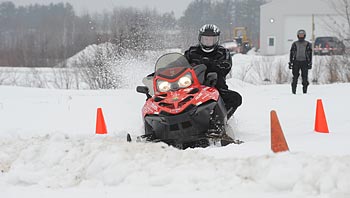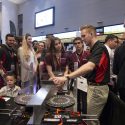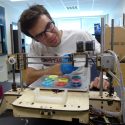Clean sweep for UW-Madison snowmobile team
Two University of Wisconsin–Madison student-built snowmobiles swept the 2009 Society of Automotive Engineers (SAE) Clean Snowmobile Challenge, winning both competition divisions: the National Science Foundation Award for the best sled in the zero-emissions division and the International Snowmobile Manufacturers Association Award for first place in the internal-combustion division.

The Bucky 750 Clean Fuel Sled.
The annual event, hosted each year by the Keweenaw Research Center on the Michigan Tech campus in Houghton, Mich., tests teams’ abilities to operate a conventional snowmobile on flex-fuel, with varying ratios of ethanol and gasoline. The sleds compete for design, noise, emissions, acceleration, handling, weight, cost and fuel economy.
Although the weather turned unseasonably warm during the competition March 16-21, the UW–Madison snowmobiles excelled in the less-than-ideal snowmobile trial conditions. The teams plowed through slush and splashed through standing water during the 70-mile endurance event.
With its flex-fuel entry, the Bucky 750 Clean Fuel Sled, the team flexed its alternative-fuels knowledge while posting a new record for exhaust cleanliness — more than 15 times cleaner than the next competitor. The “home-grown” fuel formula included ethanol from United Wisconsin Grain Producers LLC (Friesland, Wis.) and an exhaust catalyst system from W.C. Heraeus GmbH (Milwaukee). Using a controller and software from Woodward’s Mototron Control Solutions (Oshkosh, Wis.), the students refined their sled to automatically adjust to any blend of ethanol while producing virtually no exhaust emissions.
The Wisconsin team also repeated its 2008 victory with its electric snowmobile, Bucky EV. After winning last year’s competition, Bucky EV spent the summer at the National Science Foundation’s Greenland Research Facility, Summit Station, pulling equipment in environmentally sensitive areas. Bucky EV cut days from most experiments by eliminating the need to manually pull equipment to distant locations. In fall 2008, Bucky EV traveled to the Alaskan Federation of Natives Annual Convention, where it received a very hospitable welcome. The remote villages of Alaska have no roads and use snow machines as their major form of transportation — although fuel costs upwards of $12 a gallon. On average, a Bucky EV would save a villager $50 per week in fuel costs.
“We’ve got lots more miles on the sled than last year,” says team captain Nick Rakovec. “Real-world testing is a major part of engineering. You can have the best design in the world on a computer, but it’s a whole different world on the trails.”
For the 2009 competition, the team equipped Bucky EV with a new battery pack and added traction enhancements. The sled provides a whopping 100 horsepower during acceleration — faster than most of the combustion sleds. For the second year, Bucky EV won the judges award for best subjective handling.
In addition to wining the overall competitions, both sleds earned numerous awards. The Bucky 750 won the Land and Sea Award for Best Performance and the AVL Award for Best Emissions, while Bucky EV took both the Polaris Industries Award for Best Handling and the DENSO Corporation Award for Best Ride, unusual accomplishments for a battery-powered sled. In addition, UW–Madison won the Society of Automotive Engineers Award for Best Design in both the internal-combustion and zero-emissions categories.
“I almost had a heart attack at the end,” says Rakovec. “It’s almost too good to be true.”
The team would like to acknowledge its major sponsors, which allow the students to apply their engineering fundamental in a real-world application: Polaris Industries, United Wisconsin Grain Producers, Weber Motor AG and Woodward-Mototron Control Solutions.
Tags: engineering, student awards



